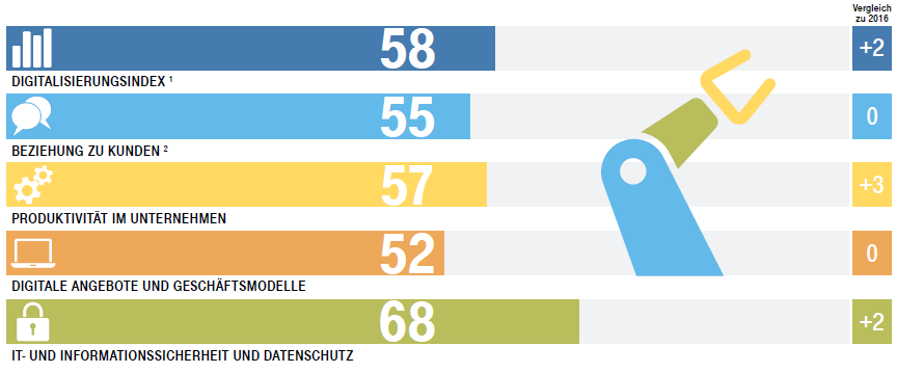Nine reasons why People are more important than Technology
The Digitalisation of B2B Marketing appears to have run out of steam among German mid-size manufacturing organisations (the ‘Mittelstand’).* It may sounds like a regional issue, but it’s not; in fact, it’s symptomatic of a global trend. “Why?” is an interesting question. But it’s more useful to ask, “What to do about it?”.
Executive Summary:
CMOs will make faster progress and get more value from the Digitalisation of
B2B Marketing if they switch their focus from technology to people.
Why? – Issues with Technology
1. We have enough technology already.
The anecdotal evidence suggests that most B2B organisations already have all the technology they need: a website with content management system plus analytics, search tools to optimise organic findability, advertising or Social media sites to maximise reach, email systems for nurturing and outbound communication, perhaps even a CRM that hooks into the ERP system. They often have a whole lot more besides.
The research report on Marketing among mid-size firms by Saxoprint indicates that online marketing is taking a growing share of the marketing budget: currently 24%, and set to increase to 33% in two years’ time.
2. We don’t need more technology
The proportion of businesses that have outgrown their current system and genuinely require additional functionality, is very small. The reality is that – for most organisations – the functionality of current online marketing systems is not fully exploited. In fact, having too many systems can actually cause problems.
“Data silos and a lack of data quality often stand in the way of a better digital customer relationship,” reported ComputerWoche in April 2017. Common complaints are that data is siloed, duplicated, low quality, redundant or can’t be integrated into information flows across departments.
3. Changing technology incurs heavy costs.
Switching to a new system involves duplication and transition. First the costs of running two systems in parallel for two, if not three quarters, before the old system can be turned off. Then additionally, there are change management issues: the direct costs of re-training users in different systems; and the loss of efficiency while defining new business processes and learning new working habits. This is not a route to be taken lightly.
Implications for People
4. Digital Unicorns and other mythical creatures
There has been increasing demand in 2017 for Digital Marketers who have expert user status in multiple online toolsets. For example, job adverts looking for: “SEO plus PPC plus CMS plus eMail plus creating Content for Blogs and Social sites”. The reality is that each of these areas is a specialisation in its own right. So is this a sensible expectation? Well, that’s a completely different matter.
The German language has an expression that really sums it up well: an “eierlegendes Wollmilchschwein” is an animal that lays eggs, gives wool, produces milk and makes a brilliant rasher of bacon, too. It is of course, entirely imaginary. The English expression ‘Jack of all trades, Master of none’ also springs to mind.
A global issue
So far, I’ve been talking about the German mid-size market. But a 2017 report published by CEB (a global research-based organisation, now owned by Gartner) indicates that this pattern is far more widespread.
In its report “2017–18 Marketing Talent Trends” CEB notes a “robust increase” in investment on systems and technology over the past three years (currently between 7% and 10% of the entire budget). The bulk of this, says CEB, is going toward digital investments, “particularly those around personalization”.
But is all that investment doing any good? Says CEB: “our 2017 data shows little to no improvement over the past three years in marketers’ core understanding of the digital landscape”.
CEB asked marketers to rate six barriers to organizational marketing excellence and came to this conclusion:
“The barrier cited least was the availability of marketing tools. In essence, marketers are telling us they don’t need more data, more machines, or more systems; they need to be upskilled to use the tools they already have.”
It’s not easy to brush this off: CEB information is based on research of its membership and its presence in all major economies. The company cites a global survey size of 93.000 respondents for this information.
Opportunities for your Business
The willingness to consider buying new technology or the ability to get new headcount approved indicates that the pain which Marketing Directors feel is very real. But, as we have seen, those standard responses – new software and / or additional staff – are unlikely to resolve the issues.
So how do you, as CMO of a mid-sized manufacturer, successfully make progress with the Digitalisation of Marketing?
5. Make more effective use of the technology you already have
This is certainly a sensible place to start. The key questions to ask – in sequence of sophistication – are:
- how to get the most out of individual technologies?
- how to combine them to fulfil specific tasks more effectively?
- how to re-design tasks to address business objectives more effectively?
These approaches begin to shift the focus from having technology to how we use it, but to make them work, they have to be more tangible …
Perhaps it’s time to get more specific and advocate two more paths:
6. Boost the budget to external agencies.
In highly specialised and skilled areas like SEO and Online advertising, inexperienced staff can actually damage your company ranking, rating, score, etc. in the short term and end up costing you more long-term.
That being so, increasing budgets to agencies is not only the fastest, but also the safest way to ramp up volume or to increase marketing reach in a short amount of time. The upcoming EU Privacy law is another area where risk-taking is a false economy. A small budget for external advice can save the Marketing department both time and reputation – and potentially a lot of money as well.
7. Invest in the productive value of your current marketing staff.
Product-based user training will help staff become more efficient with a toolset, but it will only take you so far in effectiveness. What businesses really need is hands-on knowledge transfer from highly experienced outsiders who work alongside your staff on-site. By working together on specific projects, your staff can acquire best practices, learned at top companies, quickly and effectively.
The Online Marketing processes that I designed for one client during a ten-day knowledge transfer project, for example, were used consistently every month for six years. This type of engagement often represents a highly effective investment.
What we need to do, to increase Marketing effectiveness
To raise Digitalisation of Marketing to the next level of effectiveness, I believe CMOs need to shift their attention from technology to people.
More specifically, in mid-sized organisations – which don’t have huge Marketing teams – it becomes vitally important to decide two key issues:
- which technologies are mission critical and which aren’t;
- which skillsets should stay in-house and which can be sub-contracted out.
What I’m about to suggest may sound counter-intuitive:
8. The implementation of mission-critical technologies should be sub-contracted out.
We should not be entrusting hands-on responsibility for four mission-critical technologies to the new junior employee, Jack (or Jill) Alltrades, in the naïve hope that they can deliver A-grade results across all four areas with a maximum resource of 25% FTE each.
Instead, we should be partnering with specialist agencies, each dedicated to a single field. This approach ensures that volume can be ramped up on demand. It also ensures that the activity continues throughout the year, uninterrupted by professional training, vacations or sickness.
Technology-based skillsets are just one enabler of digitalisation. In practice, additional knowledge is required.
9. The skillsets that must stay in-house are the ones we haven’t built up yet.
The CEB report asked Marketers to rank six individual barriers (as opposed to corporate barriers) to marketing excellence. The top two issues are “better define individual roles and responsibilities” and “increase collaboration among teams”. Once again CEB is citing a sample size of 93.000 respondents for this information.
So the job that needs to be done, is one that CMOs can start now: people empowerment. In my view, this means a gradual internal transition from “doing activities” to “owning processes”.
My own experience is that people relish the challenge of owning processes, taking responsibility for designing workflows, discussing and agreeing meaningful KPIs with other teams or departments, interpreting reports (created by specialist agencies), gaining insights that can be used to make iterative improvements to processes … In short, creating a closed feedback loop for a learning organisation.
Who are the best candidates for these roles? IMO, not the staff of external agencies. (This is not a reflection on their competence, but simply a corporate preference.) This is where established and trusted in-house staff members will find space to create their new roles in the digital economy. Their value to the company lies in their experience of products, customers and processes and that experience is an asset that must be nurtured and retained. At the same time, company confidential information must stay in-house. A transition from “doing activities” to “owning processes” ensures that both goals are met.
Do you agree?
Comments and feedback are welcome …
* Der “Digitalisierungsindex” in deutschen mittelständischen Unternehmen wird von TechConsult im Auftrag der Deutschen Telekomm recherchiert. Die Ergebnisse für das produzierende Gewerbe zeigen für die Bereiche “Kundenbeziehungen” und “Digitale Angebote und Geschäftsmodelle” keine Veränderung von 2016 bis 2017. Demgegenüber verbesserte sich der Bereich “Unternehmensproduktivität” gegenüber 2016 um 3 Punkte auf 58/100 im Jahr 2017, während der Index für “IT-Sicherheit und Datenschutz” um 2 Punkte auf 68/100 zulegte.



